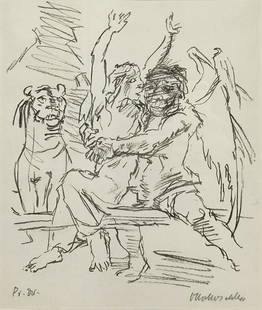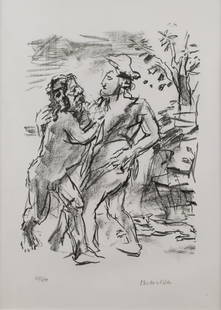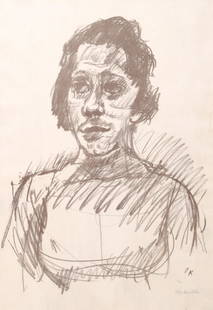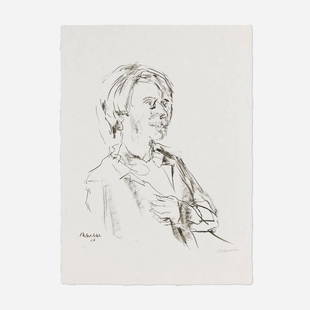
Oskar Kokoschka, Florentiner Skizzenbuch 1972
Oskar Kokoschka Sale History
View Price Results for Oskar KokoschkaRelated Prints & Multiples
More Items from Oskar Kokoschka
View MoreRecommended Art
View More


















Item Details
Description
Oskar Kokoschka, Florentiner Skizzenbuch 1972. The title page of this books reads ?Oskar Kokoschka, Florentiner Skizzenbuch, Vierundzwanzig Taseln in der GroBe der Originale Herausgegeben von Georg Theodor Ganslmayr Mit einer Einf?hrung von Heinz Spielmann, Edition Bucher Luzern?, which translates to ?Oskar Kokoschka, Florentine Sketchbook, With Twenty-four Plates in the Size of the Original, Edited by Georg Theodor Ganslmayr, With an introduction by Heinz Spielmann, Edition Bucher Lucerne?. The spine reads ?Edition Bucher, Oskar Kokoschka, Florentiner Skizzenbuch?, on beige linen boards, with the initials of Oskar Kokoschka in a brown-ruled square on the front cover, blank endpapers, a half title, then the title page, two colored lithographs that are signed by Kokoschka and laid in before the three-page introduction by Heinz Spielmann - the two lithographs are hand-colored and signed ?XX of 175? in pencil, with Kokoschka?s signature in the lower right of both lithographs - then the 24 plates, one page about the history of each plate - Zu Den Tafeln - and one page of Itinerar Der Reisen, Aug Denen Zie Zeichnungen Enstanden - an Itinerary of the journeys on which the drawings were made; the book comes in a beige linen slipcase, and it is a limited and numbered first edition that was published in Lucerne in 1972.The copyright page reads ?Oskar Kokoschka, Florentiner Skizzenbuch, erscheint in deutscher und englische Sprache in folgenden Ausf?hrungen und Auflagen: Normalausgabe, je 300 Exemplare, numeriert von I bis 300; Vorzugsausgabe, je 100 Exemplare, numeriert vom LXXVI bis CLXXV, mit einer numerierten, signierten und auf B?tten gedruckten Hand-Lithographiegedruckten Original-Lithographie (nach Raffael, Papst Leo X.); Vorzugssonderausgabe, je 75 Exemplare, numeriert von I bis LXXV, mit der Original-Lithographie der Vorzugssonderausgabe und einer farbigen, signierten und numerierten, auf B?tten gedruckten Hand-Lithographie gedruckten Hand-Lithographie (nach Bartolommeo Ammanati, FluBgott vom Neptun-Brunnen, Florenz), Dieses Exemplar tragt die Nummer XX, @ 1972 ? ?, which translates to ?Oskar Kokoschka, Florentine Sketchbook, is published in German and English in the following versions and editions: standard edition, 300 copies each, numbered from I to 300; Special edition, 100 copies each, numbered from LXXVI to CLXXV, with a numbered, signed and original lithograph printed on laid paper (after Raphael, Pope Leo X); Special deluxe edition, 75 copies each, numbered from I to LXXV, with the original lithograph of the special deluxe edition and a colored, signed and numbered lithograph printed on laid paper (after Bartolommeo Ammanati, FluBgott vom Neptune-Fountain, Florence)?. Oskar Kokoschka (1886 - 1980) was an Austrian expressionist writer and painter. Born in P?chlarn, he began his training at the age of 18 when he was awarded a scholarship to attend the Kunstgewerbeschule (now the University of Applied Arts) in Vienna, where he studied lithography and drawing under the tutelage of artists such as Gustav Klimt. Nevertheless, his financial situation was precarious and forced him to spend most of his time on decorative work, but in 1908 he met Adolf Loos, an eminent Viennese architect who was impressed by Kokoschka?s early paintings and became his main mentor, and this enabled the 22-year-old to find his way in the art world. His work had a resolutely expressionist style, where he aspired to capture the personality and character of his subjects, rather than their physical appearance. Kokoschka studied there from 1904 to 1909 and had no formal training in painting, so he approached the medium without regard to the "traditional" or "correct" way to paint. His first commissions were postcards and drawings for children, and his early career was marked by portraits of Viennese celebrities, painted in a nervously animated style. The 17th-century Czech humanist and education reformer, Jan Amos Comenius, was a primary influence on how to approach education. From Comenius?s theories, Kokoschka adopted the belief that students benefit most from using their five senses to facilitate reasoning, and he taught through storytelling filled with mythological themes and dramatic emotion - works that drew upon the subconscious rather than optical vision. This concept, in accord with Kandinsky?s theory about spirituality in art, became the basis for what art historians understand as Viennese Expressionism.Kokoschka was appointed Commander of the Order of the British Empire in the 1959 New Year Honours; he also received the Erasmus Prize in 1960 together with Marc Chagall. He was naturalized as a British subject in 1947 and would only regain Austrian citizenship in 1978; he travelled briefly to the United States in 1947 before settling in Villeneuve, Switzerland in 1953, where he lived for the rest of his life. Kokoschka had much in common with his contemporary, Max Beckmann. Both maintained their independence from German Expressionism, yet are now regarded as textbook examples of the style. Nonetheless, their individualism set both apart from the movements of twentieth-century modernism. Both wrote eloquently of the need to develop the art of "seeing" - Kokoschka emphasized depth perception, while Beckmann was concerned with mystical insight into the invisible realm - and both were masters of innovative oil-painting techniques anchored in traditions of the past. Kokoschka died in Montreux, Switzerland, in 1980, and his work has been offered at auction multiple times, with prices realized from $1 to $20,395,200 (USD), depending on the size and medium of the work, and the book and lithographs here are exquisite. The book is a large 4to. and measures 18 3/4 x 14 3/8 in. wide, in a tight binding with clean text and clean lithographs, a combination that is hard to beat, and the slipcase is exquisite as well. #5447
Buyer's Premium
- 28%
Oskar Kokoschka, Florentiner Skizzenbuch 1972
Estimate $200 - $400
5 bidders are watching this item.
Shipping & Pickup Options
Item located in SARASOTA, FL, usSee Policy for Shipping
Local Pickup Available
Payment
Accepts seamless payments through LiveAuctioneers

TOP


































































